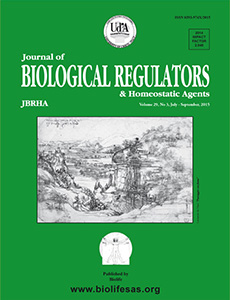JOURNAL OF BIOLOGICAL REGULATORS & HOMEOSTATIC AGENTS
L. SCAPOLI1, A. GIRARDI1, A. PALMIERI1, M. MARTINELLI1, F. CURA1, D. LAURITANO2 and F.CARINCI3
1Department of Experimental, Diagnostic and Specialty Medicine, University di Bologna, Bologna,
Italy;
2Department of Translational medicine and surgery, Neuroscience Centre of Milan, University
of Milano Bicocca, Monza, Italy;
3Department of Morphology, Surgery and Experimental Medicine, University of Ferrara, Ferrara, Italy
Periodontal tissues surround the teeth and provide their attachment. Periodontal diseases include a mild and reversible form named gingivitis, and periodontitis that is the main cause of tooth loss in adults. Gingivitis, that affects gums and coronal junctional epithelium, as well as periodontitis, that is
characterized by loss of connective tissue attachment, are caused by a persistent inflammatory response promoted by alteration of periodontal biofilm. The aim of the study was to test whether the prevalence or relative amount of each species was associated with a particular clinical condition. Periodontal
evaluation of 539 unrelated patients was performed by the Periodontal Screening and Recording (PSR) system. Subgingival samples were obtained from the site with the worst PSR score. A selection of eleven bacterial species was evaluated by quantitative real time PCR. Some bacterial species were found to be associated with all phases of periodontal disease, such as Tannerella forsythia, Treponema denticola, and Treponema lecithinolyticum, while other species were more specifically associated with periodontitis, such as Porphyromonas endodontalis and Porphyromonas gingivalis, or with gingivitis, such as Capnocytophaga ochracea and Campylobacter rectus. Quantitative and qualitative analyses helps to better understand the microbial changes associated with different stages of periodontal disease.

